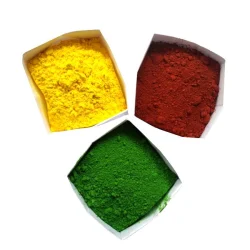Types of synthetic inorganic pigments and their characteristics
2023-12-18
Synthetic inorganic pigments are colorants produced through chemical synthesis, often involving the combination of minerals and other inorganic compounds. These pigments are engineered to provide a wide range of colors, and they offer several advantages, including high color strength, stability, and resistance to environmental factors. Here are some common types of synthetic inorganic pigments and their characteristics:
1. Titanium Dioxide (White):
- Chemical Formula: TiO2
- Characteristics: Widely used as a white pigment in paints, coatings, plastics, and cosmetics due to its brightness and opacity.
2. Iron Oxides (Red, Yellow, Brown, Black):
- Chemical Formulas:
- Red Iron Oxide: Fe2O3
- Yellow Iron Oxide: Fe2O3 · H2O
- Brown Iron Oxide: Mixtures of red and yellow iron oxides
- Black Iron Oxide: Fe3O4
- Characteristics: Versatile pigments used in a variety of applications, including paints, coatings, plastics, and construction materials.
3. Ultramarine Blue:
- Chemical Formula: Na8-10Al6Si6O24S2-4
- Characteristics: Intense blue pigment used in paints, plastics, and cosmetics. Originally derived from the mineral lapis lazuli, synthetic production offers a more economical alternative.
4. Chrome Yellow (Lead Chromate):
- Chemical Formula: PbCrO4
- Characteristics: Bright yellow pigment used in paints and coatings. Lead chromate has been largely replaced by other formulations due to environmental concerns.
5. Cadmium Pigments (Yellow, Orange, Red):
- Chemical Formulas:
- Cadmium Yellow: CdS
- Cadmium Orange: CdS · Se
- Cadmium Red: CdSe
- Characteristics: Intense and vibrant colors used in artists' paints. Cadmium pigments have raised environmental concerns due to the toxicity of cadmium.
6. Zinc Oxide (White):
- Chemical Formula: ZnO
- Characteristics: Used as a white pigment in various applications, including paints, cosmetics, and rubber.
7. Chromium Oxide Green:
- Chemical Formula: Cr2O3
- Characteristics: A green pigment used in paints, plastics, and ceramics. Known for its durability and resistance to light and heat.
8. Manganese Violet:
- Chemical Formula: Mn2O3 · 2H2O
- Characteristics: Purple pigment used in cosmetics, plastics, and coatings.
9. Cobalt Blue:
- Chemical Formulas: CoAl2O4 or CoO · Al2O3
- Characteristics: Intense blue pigment used in ceramics, glass, and artists' paints.
10. Nickel Titanium Yellow:
- Chemical Formula: NiTiO3
- Characteristics: Yellow pigment used in ceramics and plastics.
11. Prussian Blue:
- Chemical Formula: Varies; typically Fe4[Fe(CN)6]3 or Fe7(CN)18(H2O)14
- Characteristics: Deep blue pigment with applications in paints, inks, and dyes.
12. Cerium Sulfide (Yellow):
- Chemical Formula: Ce2(SO4)3
- Characteristics: Yellow pigment used in ceramics, glass, and plastics.
Synthetic inorganic pigments are widely used in various industries due to their stability, color consistency, and versatility. It's important to note that the environmental impact and safety considerations associated with certain inorganic pigments, such as lead-based pigments or cadmium pigments, have led to the development and adoption of alternative formulations with reduced toxicity. As a result, regulations and industry standards aim to promote the use of safer pigments while maintaining desired color characteristics.



